802.11 WLAN Data Throughput and Security Overheads
VerifiedAdded on 2023/06/12
|8
|1796
|78
AI Summary
This study evaluates the security methodologies and their effects on the 802.11 WLAN systems. It estimates the amount of throughput achieved by each node of WLAN accurately, where each node has diverse characteristics depending on the transmission rates, traffic demands, and packet sizes.
Contribute Materials
Your contribution can guide someone’s learning journey. Share your
documents today.
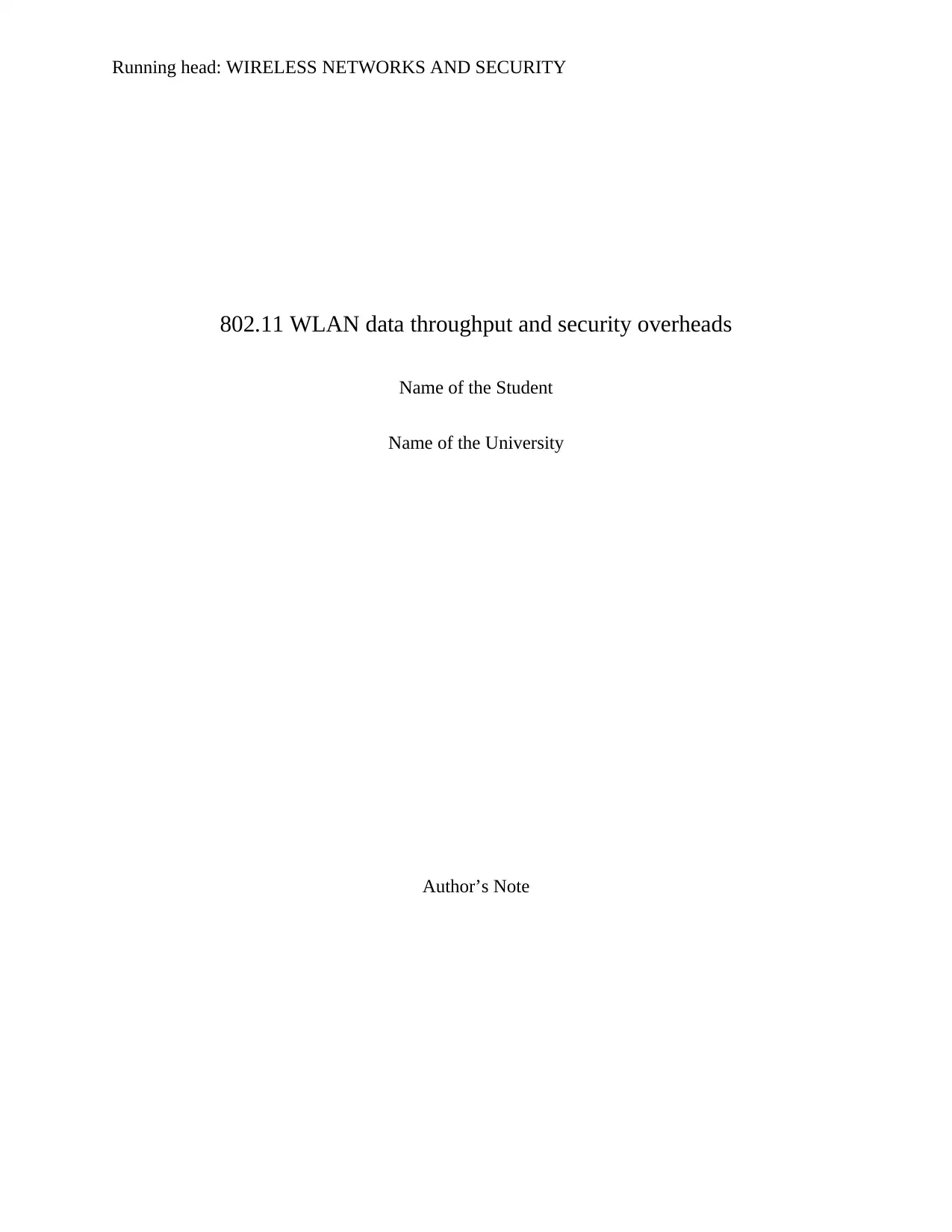
Running head: WIRELESS NETWORKS AND SECURITY
802.11 WLAN data throughput and security overheads
Name of the Student
Name of the University
Author’s Note
802.11 WLAN data throughput and security overheads
Name of the Student
Name of the University
Author’s Note
Secure Best Marks with AI Grader
Need help grading? Try our AI Grader for instant feedback on your assignments.
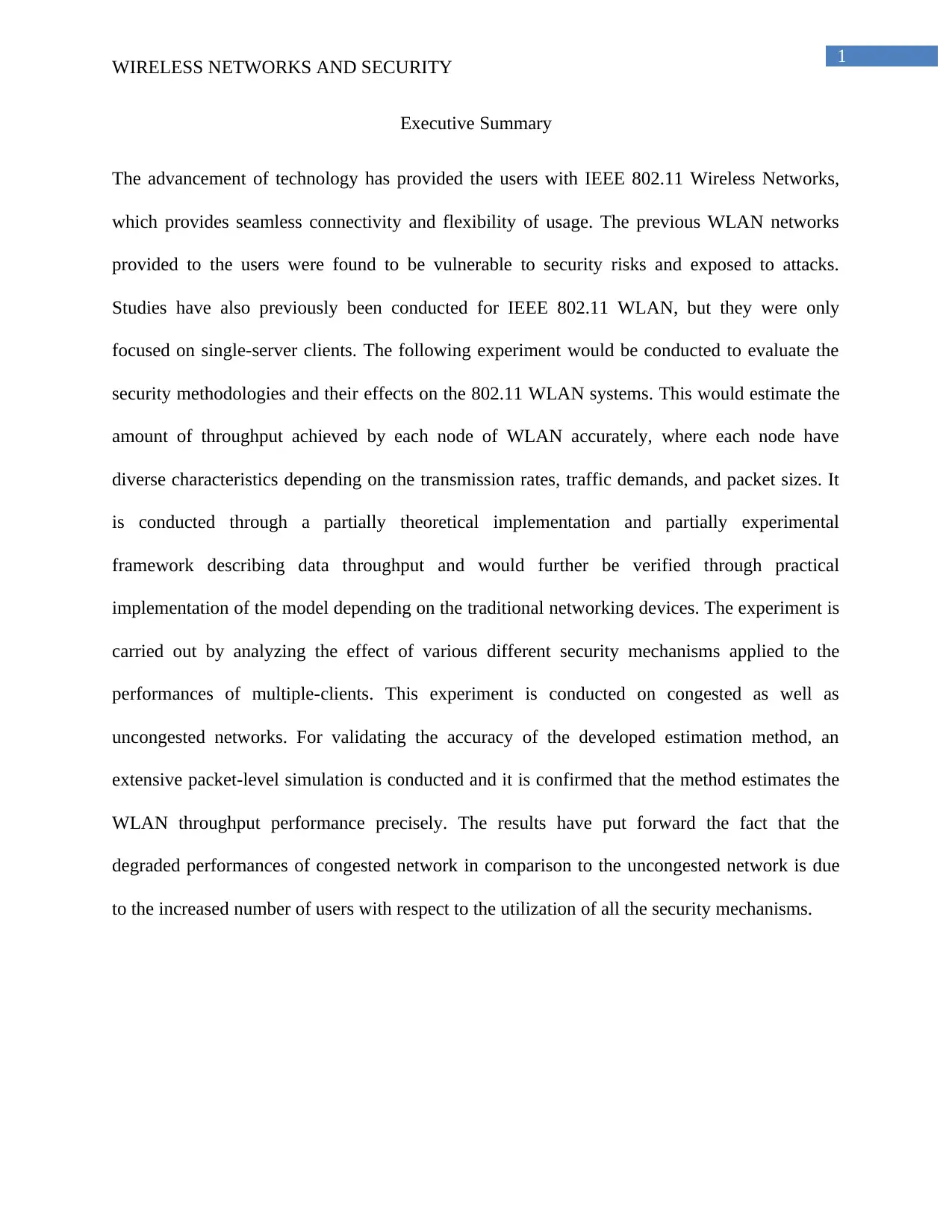
1
WIRELESS NETWORKS AND SECURITY
Executive Summary
The advancement of technology has provided the users with IEEE 802.11 Wireless Networks,
which provides seamless connectivity and flexibility of usage. The previous WLAN networks
provided to the users were found to be vulnerable to security risks and exposed to attacks.
Studies have also previously been conducted for IEEE 802.11 WLAN, but they were only
focused on single-server clients. The following experiment would be conducted to evaluate the
security methodologies and their effects on the 802.11 WLAN systems. This would estimate the
amount of throughput achieved by each node of WLAN accurately, where each node have
diverse characteristics depending on the transmission rates, traffic demands, and packet sizes. It
is conducted through a partially theoretical implementation and partially experimental
framework describing data throughput and would further be verified through practical
implementation of the model depending on the traditional networking devices. The experiment is
carried out by analyzing the effect of various different security mechanisms applied to the
performances of multiple-clients. This experiment is conducted on congested as well as
uncongested networks. For validating the accuracy of the developed estimation method, an
extensive packet-level simulation is conducted and it is confirmed that the method estimates the
WLAN throughput performance precisely. The results have put forward the fact that the
degraded performances of congested network in comparison to the uncongested network is due
to the increased number of users with respect to the utilization of all the security mechanisms.
WIRELESS NETWORKS AND SECURITY
Executive Summary
The advancement of technology has provided the users with IEEE 802.11 Wireless Networks,
which provides seamless connectivity and flexibility of usage. The previous WLAN networks
provided to the users were found to be vulnerable to security risks and exposed to attacks.
Studies have also previously been conducted for IEEE 802.11 WLAN, but they were only
focused on single-server clients. The following experiment would be conducted to evaluate the
security methodologies and their effects on the 802.11 WLAN systems. This would estimate the
amount of throughput achieved by each node of WLAN accurately, where each node have
diverse characteristics depending on the transmission rates, traffic demands, and packet sizes. It
is conducted through a partially theoretical implementation and partially experimental
framework describing data throughput and would further be verified through practical
implementation of the model depending on the traditional networking devices. The experiment is
carried out by analyzing the effect of various different security mechanisms applied to the
performances of multiple-clients. This experiment is conducted on congested as well as
uncongested networks. For validating the accuracy of the developed estimation method, an
extensive packet-level simulation is conducted and it is confirmed that the method estimates the
WLAN throughput performance precisely. The results have put forward the fact that the
degraded performances of congested network in comparison to the uncongested network is due
to the increased number of users with respect to the utilization of all the security mechanisms.
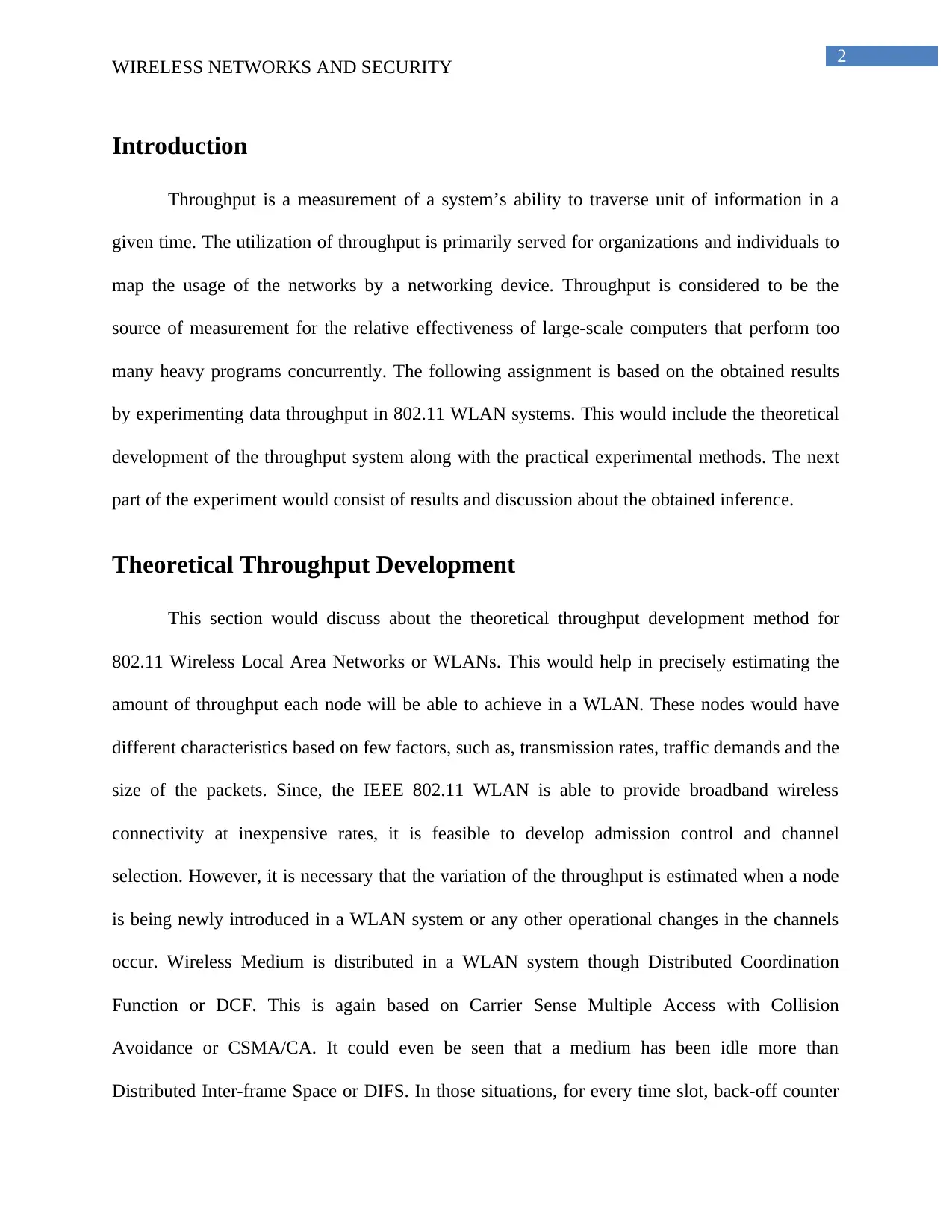
2
WIRELESS NETWORKS AND SECURITY
Introduction
Throughput is a measurement of a system’s ability to traverse unit of information in a
given time. The utilization of throughput is primarily served for organizations and individuals to
map the usage of the networks by a networking device. Throughput is considered to be the
source of measurement for the relative effectiveness of large-scale computers that perform too
many heavy programs concurrently. The following assignment is based on the obtained results
by experimenting data throughput in 802.11 WLAN systems. This would include the theoretical
development of the throughput system along with the practical experimental methods. The next
part of the experiment would consist of results and discussion about the obtained inference.
Theoretical Throughput Development
This section would discuss about the theoretical throughput development method for
802.11 Wireless Local Area Networks or WLANs. This would help in precisely estimating the
amount of throughput each node will be able to achieve in a WLAN. These nodes would have
different characteristics based on few factors, such as, transmission rates, traffic demands and the
size of the packets. Since, the IEEE 802.11 WLAN is able to provide broadband wireless
connectivity at inexpensive rates, it is feasible to develop admission control and channel
selection. However, it is necessary that the variation of the throughput is estimated when a node
is being newly introduced in a WLAN system or any other operational changes in the channels
occur. Wireless Medium is distributed in a WLAN system though Distributed Coordination
Function or DCF. This is again based on Carrier Sense Multiple Access with Collision
Avoidance or CSMA/CA. It could even be seen that a medium has been idle more than
Distributed Inter-frame Space or DIFS. In those situations, for every time slot, back-off counter
WIRELESS NETWORKS AND SECURITY
Introduction
Throughput is a measurement of a system’s ability to traverse unit of information in a
given time. The utilization of throughput is primarily served for organizations and individuals to
map the usage of the networks by a networking device. Throughput is considered to be the
source of measurement for the relative effectiveness of large-scale computers that perform too
many heavy programs concurrently. The following assignment is based on the obtained results
by experimenting data throughput in 802.11 WLAN systems. This would include the theoretical
development of the throughput system along with the practical experimental methods. The next
part of the experiment would consist of results and discussion about the obtained inference.
Theoretical Throughput Development
This section would discuss about the theoretical throughput development method for
802.11 Wireless Local Area Networks or WLANs. This would help in precisely estimating the
amount of throughput each node will be able to achieve in a WLAN. These nodes would have
different characteristics based on few factors, such as, transmission rates, traffic demands and the
size of the packets. Since, the IEEE 802.11 WLAN is able to provide broadband wireless
connectivity at inexpensive rates, it is feasible to develop admission control and channel
selection. However, it is necessary that the variation of the throughput is estimated when a node
is being newly introduced in a WLAN system or any other operational changes in the channels
occur. Wireless Medium is distributed in a WLAN system though Distributed Coordination
Function or DCF. This is again based on Carrier Sense Multiple Access with Collision
Avoidance or CSMA/CA. It could even be seen that a medium has been idle more than
Distributed Inter-frame Space or DIFS. In those situations, for every time slot, back-off counter

3
WIRELESS NETWORKS AND SECURITY
is decreased. However, since the topology of WLAN also affects the behavior of a node in the
distributed system, predicting the same becomes complicated.
Experimental Method
The experimental method would include consideration for few factors like design
decisions, configuration of the WLAN system, the checking of the security layers, the
implementation of the 802.1x model, and the traffic generators in the system required to carry
out before the commencing of the task.
For design decisions, the most necessary considerations are to be made for the
experiment is traffic generators, the security layers, and the performance measurements.
For the configuration of the WLAN system, the experiment is to be carried out in
Windows-based operating systems since it has an in-built property to implement IEEE 802.1x
authentication protocol.
The security layers are selected based on the hierarchy of the available security
mechanisms for 802.11 security standards. These eight security measures are; no security, MAC
address authentication, WEP authentication with 40-bit and 128-bit WEP encryption, and EAP-
TLS authentication.
The model implementation for 802.11 WLAN systems would include open and shared key
authentication for access mechanism. The chosen authentication method for this purpose would
be the EAP-TLS.
For measuring the traffic generator, the IP Traffic tool was found to be most appropriate
based on the purpose and this was implemented to carry on the experiment.
WIRELESS NETWORKS AND SECURITY
is decreased. However, since the topology of WLAN also affects the behavior of a node in the
distributed system, predicting the same becomes complicated.
Experimental Method
The experimental method would include consideration for few factors like design
decisions, configuration of the WLAN system, the checking of the security layers, the
implementation of the 802.1x model, and the traffic generators in the system required to carry
out before the commencing of the task.
For design decisions, the most necessary considerations are to be made for the
experiment is traffic generators, the security layers, and the performance measurements.
For the configuration of the WLAN system, the experiment is to be carried out in
Windows-based operating systems since it has an in-built property to implement IEEE 802.1x
authentication protocol.
The security layers are selected based on the hierarchy of the available security
mechanisms for 802.11 security standards. These eight security measures are; no security, MAC
address authentication, WEP authentication with 40-bit and 128-bit WEP encryption, and EAP-
TLS authentication.
The model implementation for 802.11 WLAN systems would include open and shared key
authentication for access mechanism. The chosen authentication method for this purpose would
be the EAP-TLS.
For measuring the traffic generator, the IP Traffic tool was found to be most appropriate
based on the purpose and this was implemented to carry on the experiment.
Secure Best Marks with AI Grader
Need help grading? Try our AI Grader for instant feedback on your assignments.
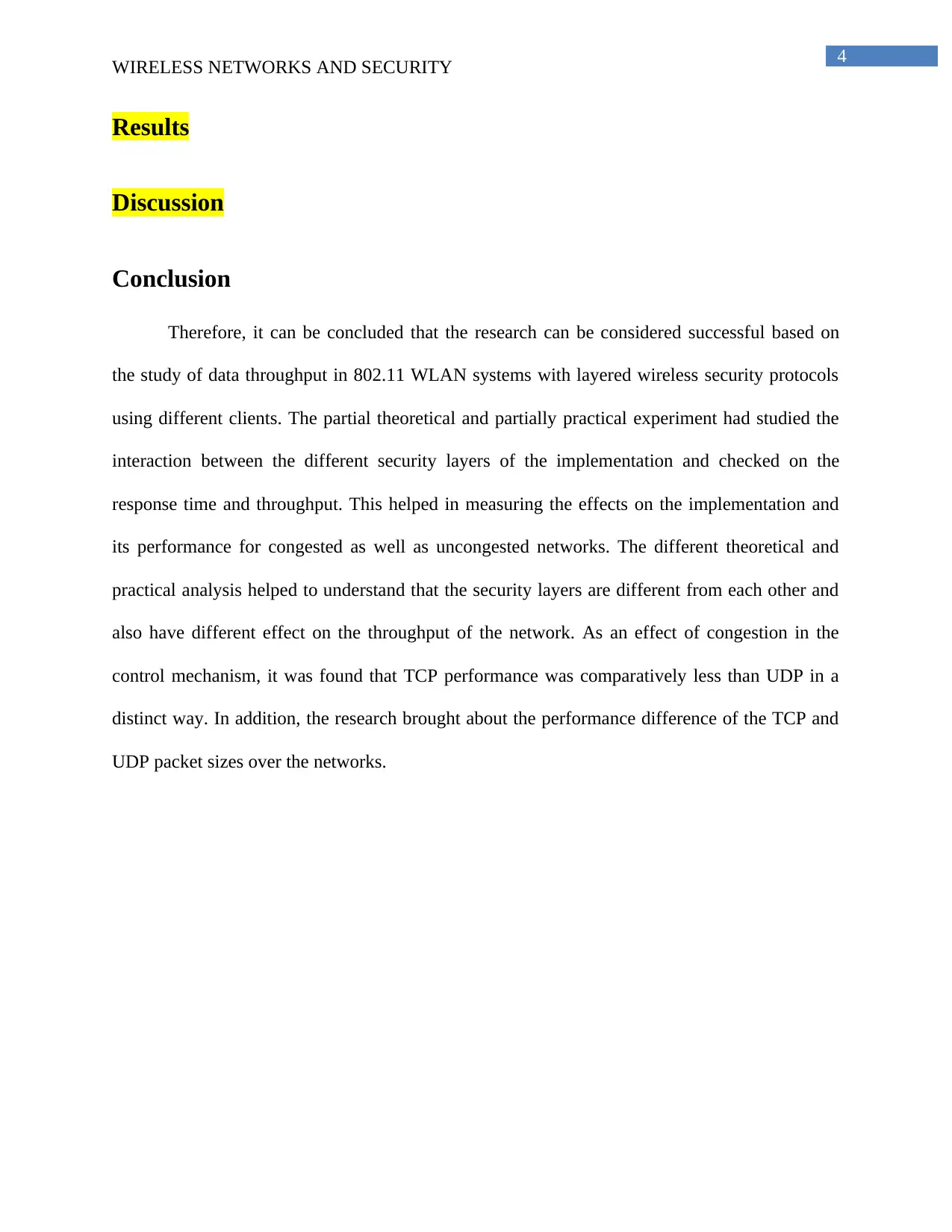
4
WIRELESS NETWORKS AND SECURITY
Results
Discussion
Conclusion
Therefore, it can be concluded that the research can be considered successful based on
the study of data throughput in 802.11 WLAN systems with layered wireless security protocols
using different clients. The partial theoretical and partially practical experiment had studied the
interaction between the different security layers of the implementation and checked on the
response time and throughput. This helped in measuring the effects on the implementation and
its performance for congested as well as uncongested networks. The different theoretical and
practical analysis helped to understand that the security layers are different from each other and
also have different effect on the throughput of the network. As an effect of congestion in the
control mechanism, it was found that TCP performance was comparatively less than UDP in a
distinct way. In addition, the research brought about the performance difference of the TCP and
UDP packet sizes over the networks.
WIRELESS NETWORKS AND SECURITY
Results
Discussion
Conclusion
Therefore, it can be concluded that the research can be considered successful based on
the study of data throughput in 802.11 WLAN systems with layered wireless security protocols
using different clients. The partial theoretical and partially practical experiment had studied the
interaction between the different security layers of the implementation and checked on the
response time and throughput. This helped in measuring the effects on the implementation and
its performance for congested as well as uncongested networks. The different theoretical and
practical analysis helped to understand that the security layers are different from each other and
also have different effect on the throughput of the network. As an effect of congestion in the
control mechanism, it was found that TCP performance was comparatively less than UDP in a
distinct way. In addition, the research brought about the performance difference of the TCP and
UDP packet sizes over the networks.
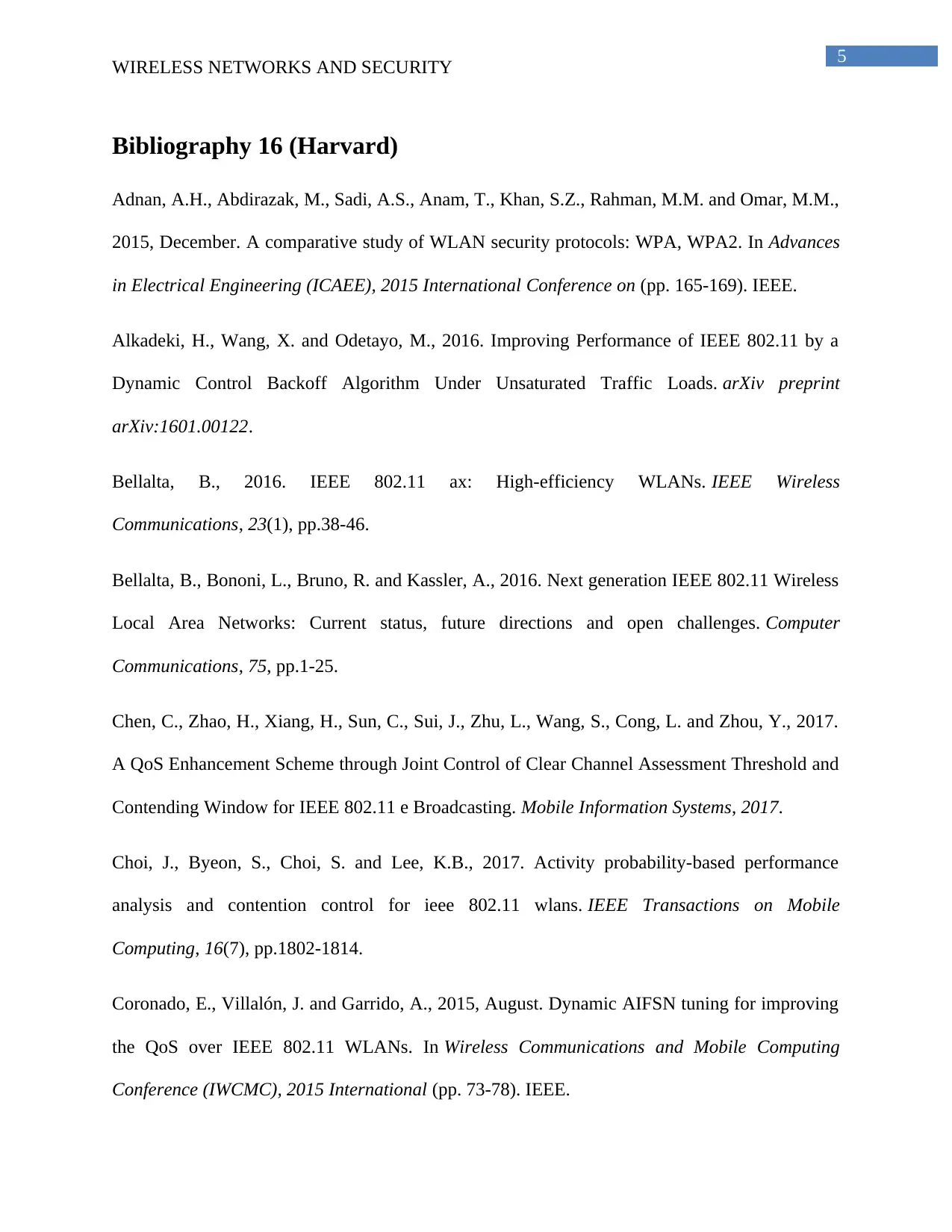
5
WIRELESS NETWORKS AND SECURITY
Bibliography 16 (Harvard)
Adnan, A.H., Abdirazak, M., Sadi, A.S., Anam, T., Khan, S.Z., Rahman, M.M. and Omar, M.M.,
2015, December. A comparative study of WLAN security protocols: WPA, WPA2. In Advances
in Electrical Engineering (ICAEE), 2015 International Conference on (pp. 165-169). IEEE.
Alkadeki, H., Wang, X. and Odetayo, M., 2016. Improving Performance of IEEE 802.11 by a
Dynamic Control Backoff Algorithm Under Unsaturated Traffic Loads. arXiv preprint
arXiv:1601.00122.
Bellalta, B., 2016. IEEE 802.11 ax: High-efficiency WLANs. IEEE Wireless
Communications, 23(1), pp.38-46.
Bellalta, B., Bononi, L., Bruno, R. and Kassler, A., 2016. Next generation IEEE 802.11 Wireless
Local Area Networks: Current status, future directions and open challenges. Computer
Communications, 75, pp.1-25.
Chen, C., Zhao, H., Xiang, H., Sun, C., Sui, J., Zhu, L., Wang, S., Cong, L. and Zhou, Y., 2017.
A QoS Enhancement Scheme through Joint Control of Clear Channel Assessment Threshold and
Contending Window for IEEE 802.11 e Broadcasting. Mobile Information Systems, 2017.
Choi, J., Byeon, S., Choi, S. and Lee, K.B., 2017. Activity probability-based performance
analysis and contention control for ieee 802.11 wlans. IEEE Transactions on Mobile
Computing, 16(7), pp.1802-1814.
Coronado, E., Villalón, J. and Garrido, A., 2015, August. Dynamic AIFSN tuning for improving
the QoS over IEEE 802.11 WLANs. In Wireless Communications and Mobile Computing
Conference (IWCMC), 2015 International (pp. 73-78). IEEE.
WIRELESS NETWORKS AND SECURITY
Bibliography 16 (Harvard)
Adnan, A.H., Abdirazak, M., Sadi, A.S., Anam, T., Khan, S.Z., Rahman, M.M. and Omar, M.M.,
2015, December. A comparative study of WLAN security protocols: WPA, WPA2. In Advances
in Electrical Engineering (ICAEE), 2015 International Conference on (pp. 165-169). IEEE.
Alkadeki, H., Wang, X. and Odetayo, M., 2016. Improving Performance of IEEE 802.11 by a
Dynamic Control Backoff Algorithm Under Unsaturated Traffic Loads. arXiv preprint
arXiv:1601.00122.
Bellalta, B., 2016. IEEE 802.11 ax: High-efficiency WLANs. IEEE Wireless
Communications, 23(1), pp.38-46.
Bellalta, B., Bononi, L., Bruno, R. and Kassler, A., 2016. Next generation IEEE 802.11 Wireless
Local Area Networks: Current status, future directions and open challenges. Computer
Communications, 75, pp.1-25.
Chen, C., Zhao, H., Xiang, H., Sun, C., Sui, J., Zhu, L., Wang, S., Cong, L. and Zhou, Y., 2017.
A QoS Enhancement Scheme through Joint Control of Clear Channel Assessment Threshold and
Contending Window for IEEE 802.11 e Broadcasting. Mobile Information Systems, 2017.
Choi, J., Byeon, S., Choi, S. and Lee, K.B., 2017. Activity probability-based performance
analysis and contention control for ieee 802.11 wlans. IEEE Transactions on Mobile
Computing, 16(7), pp.1802-1814.
Coronado, E., Villalón, J. and Garrido, A., 2015, August. Dynamic AIFSN tuning for improving
the QoS over IEEE 802.11 WLANs. In Wireless Communications and Mobile Computing
Conference (IWCMC), 2015 International (pp. 73-78). IEEE.

6
WIRELESS NETWORKS AND SECURITY
Deng, D.J., Chen, K.C. and Cheng, R.S., 2014, August. IEEE 802.11 ax: Next generation
wireless local area networks. In Heterogeneous networking for quality, reliability, security and
robustness (QShine), 2014 10th international conference on(pp. 77-82). IEEE.
Deng, D.J., Lien, S.Y., Lee, J. and Chen, K.C., 2016. On quality-of-service provisioning in IEEE
802.11 ax WLANs. IEEE Access, 4, pp.6086-6104.
Deng, X., He, L., Zhu, C., Dong, M., Ota, K. and Cai, L., 2016. QoS-aware and load-balance
routing for IEEE 802.11 s based neighborhood area network in smart grid. Wireless Personal
Communications, 89(4), pp.1065-1088.
Jopen, S.A., Schulz, A. and Ernst, R., 2015, October. Measuring and modeling performance of
WLAN communication for multistatic sonar applications. In Local Computer Networks (LCN),
2015 IEEE 40th Conference on(pp. 382-385). IEEE.
Kaur, A. and Grover, A., 2015. Capacity Estimation of an Infrastructure Network Carrying
HTTP and E-Mail Data based on IEEE 802.11 b WLAN Standard. International Journal of
Computer Applications, 123(16).
Malik, A., Qadir, J., Ahmad, B., Yau, K.L.A. and Ullah, U., 2015. QoS in IEEE 802.11-based
wireless networks: a contemporary review. Journal of Network and Computer Applications, 55,
pp.24-46.
Miranda, A.B.F. and Knightly, E.W., William Marsh Rice University, 2017. Dual channel Wi-Fi
for congested WLANs with asymmetric traffic loads. U.S. Patent 9,820,336.
WIRELESS NETWORKS AND SECURITY
Deng, D.J., Chen, K.C. and Cheng, R.S., 2014, August. IEEE 802.11 ax: Next generation
wireless local area networks. In Heterogeneous networking for quality, reliability, security and
robustness (QShine), 2014 10th international conference on(pp. 77-82). IEEE.
Deng, D.J., Lien, S.Y., Lee, J. and Chen, K.C., 2016. On quality-of-service provisioning in IEEE
802.11 ax WLANs. IEEE Access, 4, pp.6086-6104.
Deng, X., He, L., Zhu, C., Dong, M., Ota, K. and Cai, L., 2016. QoS-aware and load-balance
routing for IEEE 802.11 s based neighborhood area network in smart grid. Wireless Personal
Communications, 89(4), pp.1065-1088.
Jopen, S.A., Schulz, A. and Ernst, R., 2015, October. Measuring and modeling performance of
WLAN communication for multistatic sonar applications. In Local Computer Networks (LCN),
2015 IEEE 40th Conference on(pp. 382-385). IEEE.
Kaur, A. and Grover, A., 2015. Capacity Estimation of an Infrastructure Network Carrying
HTTP and E-Mail Data based on IEEE 802.11 b WLAN Standard. International Journal of
Computer Applications, 123(16).
Malik, A., Qadir, J., Ahmad, B., Yau, K.L.A. and Ullah, U., 2015. QoS in IEEE 802.11-based
wireless networks: a contemporary review. Journal of Network and Computer Applications, 55,
pp.24-46.
Miranda, A.B.F. and Knightly, E.W., William Marsh Rice University, 2017. Dual channel Wi-Fi
for congested WLANs with asymmetric traffic loads. U.S. Patent 9,820,336.
Paraphrase This Document
Need a fresh take? Get an instant paraphrase of this document with our AI Paraphraser
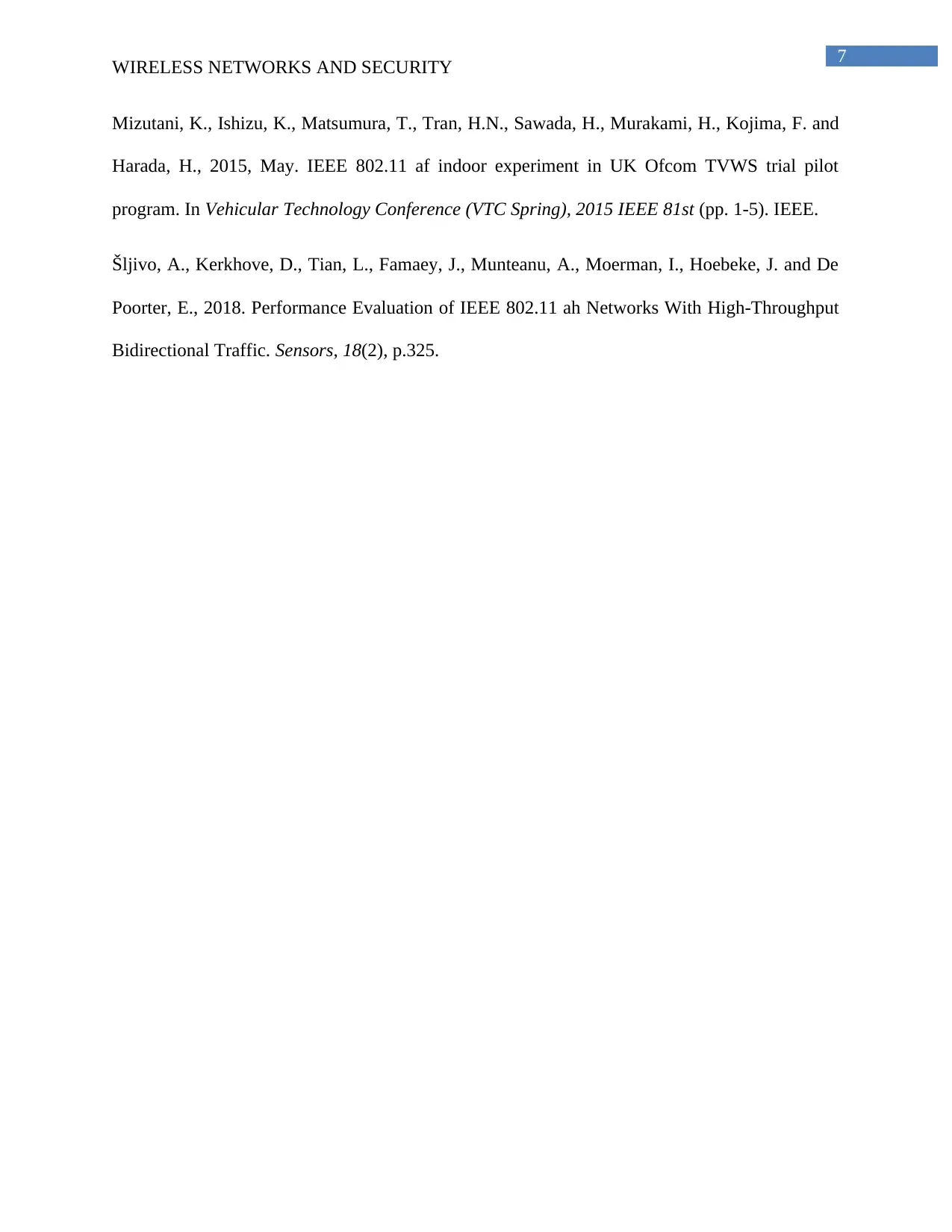
7
WIRELESS NETWORKS AND SECURITY
Mizutani, K., Ishizu, K., Matsumura, T., Tran, H.N., Sawada, H., Murakami, H., Kojima, F. and
Harada, H., 2015, May. IEEE 802.11 af indoor experiment in UK Ofcom TVWS trial pilot
program. In Vehicular Technology Conference (VTC Spring), 2015 IEEE 81st (pp. 1-5). IEEE.
Šljivo, A., Kerkhove, D., Tian, L., Famaey, J., Munteanu, A., Moerman, I., Hoebeke, J. and De
Poorter, E., 2018. Performance Evaluation of IEEE 802.11 ah Networks With High-Throughput
Bidirectional Traffic. Sensors, 18(2), p.325.
WIRELESS NETWORKS AND SECURITY
Mizutani, K., Ishizu, K., Matsumura, T., Tran, H.N., Sawada, H., Murakami, H., Kojima, F. and
Harada, H., 2015, May. IEEE 802.11 af indoor experiment in UK Ofcom TVWS trial pilot
program. In Vehicular Technology Conference (VTC Spring), 2015 IEEE 81st (pp. 1-5). IEEE.
Šljivo, A., Kerkhove, D., Tian, L., Famaey, J., Munteanu, A., Moerman, I., Hoebeke, J. and De
Poorter, E., 2018. Performance Evaluation of IEEE 802.11 ah Networks With High-Throughput
Bidirectional Traffic. Sensors, 18(2), p.325.
1 out of 8
Related Documents
Your All-in-One AI-Powered Toolkit for Academic Success.
+13062052269
info@desklib.com
Available 24*7 on WhatsApp / Email
![[object Object]](/_next/static/media/star-bottom.7253800d.svg)
Unlock your academic potential
© 2024 | Zucol Services PVT LTD | All rights reserved.
